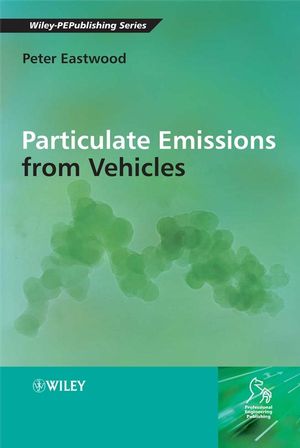Particulate Emissions from VehiclesISBN: 978-0-470-72455-2
Hardcover
512 pages
March 2008
 |
||||||
Acronyms and Abbreviations.
Chapter 1. Introduction.
Chapter 2. Fundamentals.
2.1 Introduction.
2.2 Properties of Aerosol Particles.
2.2.1 Diameter and Shape.
2.2.2 Size Distribution.
2.2.3 Transport and Deposition.
2.2.4 Transformation and Mutation.
2.3 Particles in the Atmosphere.
2.3.1 Character and Behaviour.
2.3.2 Aerosols in Nature.
2.3.3 Anthropogenic Aerosols.
2.3.4 Environmental Implications.
2.4 Motor Vehicle Particulate.
2.4.1 Some Typical Particles Dissected.
2.4.2 What happens within the Engine.
2.4.3 What Happens within the Exhaust.
2.4.4 Number versus Mass.
2.5 Closure.
Chapter 3. Formation I: Composition.
3.1 Introduction.
3.2 Carbonaceous Fraction: I.
Classical Models.
3.2.1 Empiricisms.
3.2.2 Inception.
3.2.3 Surface Growth.
3.2.4 Agglomeration.
3.2.5 Oxidation.
3.3 Carbonaceous Fraction: II.
The Combusting Plume.
3.3.1 Historical Overview.
3.3.2 Premixed Burn.
3.3.3 Mixing-Controlled Burn.
3.3.4 Late Burn.
3.4 Carbonaceous Fraction: III.
Wall Interactions.
3.4.1 Theoretical.
3.4.2 Experimental.
3.5 Ash Fraction.
3.5.1 Chemical Reactions.
3.5.2 Gas-to-Particle Conversion.
3.6 Organic Fraction.
3.6.1 Preparatory Chemical Reactions.
3.6.2 Chemical Reactions in the Exhaust.
3.6.3 Gas-Particle Conversion: Models.
3.6.4 Gas-Particle Conversion: Measurements .
3.6.5 White Smoke.
3.7 Sulphate Fraction.
3.7.1 Chemical Reactions.
3.7.2 Gas-to-Particle Conversion.
3.8 Closure.
Chapter 4. Formation II: Location.
4.1 Introduction.
4.2 Within the Exhaust System.
4.2.1 Storage and Release.
4.2.2 Deposition within Catalysts.
4.3 Within the Exhaust Plume.
4.4 Within the Transfer Line.
4.5 Within the Dilution Tunnel.
4.6 On the Filter.
4.7 Closure.
Chapter 5. Measurement.
5.1 Introduction.
5.2 Particulate Measured Conventionally.
5.2.1 Drawing a Sample of Exhaust.
5.2.2 Diluting the Exhaust.
5.2.3 Collection onto a Filter.
5.2.4 Fractionation by Gasification.
5.2.5 Fractionation by Dissolution.
5.3.6 Chemically Assaying the Organic Fraction .
5.3.7 Biologically Assaying the Organic Fraction .
5.3 Particulate Measured Individually.
5.3.1 Inertial Mobility.
5.3.2 Electrical Mobility.
5.3.3 Laser-Induced Incandescence.
5.3.4 Light Scattering.
5.4 Particulate Measured Collectively.
5.4.1 Photoacousticity.
5.4.2 Photoelectricity and Diffusion Charging.
5.4.3 Electrical Charge.
5.4.4 Flame Ionisation.
5.4.5 Mass.
5.4.6 Smoke.
5.5 Closure.
Chapter 6. Characterisation.
6.1 Introduction.
6.2 Physical Characterisation.
6.2.1 Microstructure.
6.2.2 Morphology.
6.2.3 Density.
6.2.4 Surface Area.
6.2.5 Electrical Charge.
6.3 Chemical Characterisation.
6.3.1 Carbonaceous Fraction.
6.3.2 Ash Fraction.
6.3.3 Organic Fraction.
6.3.4 Sulphate Fraction.
6.4 Biological Characterisation.
6.5 Demographical Characterisation.
6.6 Closure.
Chapter 7. Abatement.
7.1 Introduction.
7.2 Fuel Formulation.
7.2.1 Sulphur.
7.2.2 Hydrocarbons.
7.2.3 Oxygenates.
7.2.4 Additives.
7.2.5 Volatility, Cetane Number and Density.
7.3 Fuel Injection.
7.3.1 The Injector Nozzle.
7.3.2 Injection Pressure.
7.3.3 Injection Scheduling.
7.4 Exhaust Gas Recirculation.
7.5 Induction.
7.5.1 External to the Engine.
7.5.2 Internal to the Engine.
7.6 Lubrication.
7.6.1 Oil in Particulate.
7.6.2 Particulate in Oil.
7.7 Alternative Combustion.
7.8 Aftertreatment.
7.8.1 Catalytic Converters.
7.8.2 Particulate Filters.
7.9 Closure.
Chapter 8. Gasoline Engines.
8.1 Introduction.
8.2 A Historical Perspective.
8.2.1 Organometallic Fuel Additives and Ash .
8.2.2 Oxidation Catalysts and Sulphates.
8.3 Port-Injection Engines.
8.3.1 Formation.
8.3.2 Characterisation.
8.3.3 Abatement.
8.4 Direct Injection Engines.
8.4.1 Formation.
8.4.2 Characterisation.
8.4.3 Abatement.
8.4 Two-Stroke Engines.
8.5 Closure.
Chapter 9. Disintegration.
9.1 Introduction.
9.2 Roads.
9.3 Brakes.
9.4 Tyres.
9.5 Exhausts.
9.6 Catalysts.
9.7 Closure.
Chapter 10. Toxicology.
10.1 Introduction.
10.2 Public Exposure.
10.3 Public Health.
10.4 Pathogenesis.
10.5 Epidemiology.
10.6 In Vitro.
10.7 In Vivo.
10.8 Humans.
10.9 Closure.
10.10 Glossary.
Chapter 11. Closure.
11.1 Recommendations for Research.
11.2 Smaller Particles in Larger Numbers; or Larger Particles in Smaller Numbers.
11.3 Smaller and Smaller and Smaller.
11.4 Broader Questions of Policy.
Bibliography.
Literature Cited.
Subject Index.



